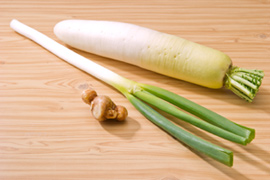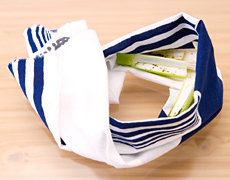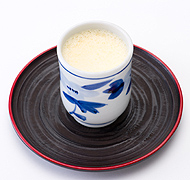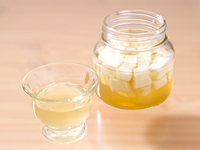Web Japan > Trends in Japan > Tech & Life > Gentle Yet Effective
Gentle Yet Effective
Japanese-style Cold Remedies
When we are infected with a virus and catch a cold, symptoms such as coughing, a sore throat, runny nose, congestion, headaches and fever appear. If we rest completely, our body's immunity gets to work, and the cold symptoms last no longer than a week or so before we recover naturally. We can take cold medicine and consult a doctor if we catch a cold, but when it comes right down to it, cold medicine and treatments might ease the symptoms, but they cannot directly cure the cold virus, especially since there are so many different strains.
Colds are tough on us, and naturally everyone wants to get better quickly and ease the symptoms. Japan has many methods for relieving the symptoms without relying on medicine.

Potherbs like daikon (above), negi (middle) and ginger (below) are said to be good remedies for colds.
Enlarge photoPotherbs to Warm the BodyOne of Japan's unique approaches to alleviating colds with everyday ingredients uses negi (Japanese leek) and ginger. These two ingredients are very familiar to Japanese people and are used as condiments with sashimi, tofu, soups and noodle dishes. Onions and ginger are also used to bring out the flavor in meat and fish dishes, and they are used in hotpot dishes. These vegetables are the reliable helpmeets that come to the mind of Japanese people when they catch a cold.
Ginger contains ingredients that have a sweat-producing and warming effect, while also killing bacteria and acting as a painkiller. When the chills come on, we warm ourselves by drinking "hot ginger water" made with the juice from freshly grated ginger.
Left: To make a "negi compress," grill some pieces of negi lightly until wilted and put them in a cloth to wrap around one's neck.
Right: For early cold signs, have some eggnog made with Japanese sake and sleep well.
Diallyl sulfide, the volatile component of onions, enhances the function of Vitamin B1 and Vitamin E, aids the weakened digestive function to restore physical strength, and warms the body. Simply drinking negi miso soup—made by pouring hot water over minced negi and miso in a bowl—is rejuvenating. Since grilling negi releases diallyl sulfides, making a "negi compress" by wrapping lightly grilled negi in a cloth and wrapping it around one's neck is said to be effective in alleviating a congested nose and sore throat.
Japan also has a custom of drinking a kind of eggnog made with sake and eggs before bed to warm the body. Japanese sake is warmed over a low flame, sugar and a beaten egg are added and heated until the potion comes together, and then this concoction is drunk while still hot. For children and people who cannot drink alcohol, you can boil the sake to evaporate the alcohol content.
Root Vegetables and Fruit for Relieving Sore ThroatsJapanese people have also traditionally used familiar vegetables and fruit to ease coughs and sore throats. Daikon (Japanese radish) can be obtained throughout the year and contains abundant minerals and vitamins. It can be used to make "daikon syrup." The method is simple. Diced daikon are steeped in honey and preserved in an airtight container. The daikon's essence seeps out in a few hours, and then the syrup is dissolved in a small amount of hot water and drunk. Daikon contains high amounts of vitamin C and digestive enzymes, and it is effective in easing throat pain.
Kinkan conserve, made with kinkan kumquats (a small citrus fruit) stewed in sugar and water, is rich in vitamin C. It also contains large amounts of flavonoids, which enhance the absorbability of vitamin C, and can curb inflammation of the mucous membrane. Many families use this conserve as a household medicine for coughs.
Simple Antipyretic for FeversWe get a fever when we have a cold because our body is fighting the virus. Since olden days, particularly high fevers have been brought down in Japan by applying a cold cloth to the forehead or putting ice in one's pillow. But this is not convenient because the ice pack can fall off or become displaced when the patient turns over while sleeping. Nowadays, cooling pads that can be affixed to the forehead to bring down fevers are sold, a particularly convenient solution for children that can't stay still. The water contained in the sheet slowly evaporates and absorbs the fever, and cooling agent capsules gradually take effect so that the cooling sensation is maintained over a long period.

A cooling pad is convenient for children's fever, as it won't fall off even when turning over while sleeping.
Enlarge photoSteps to Prevent ColdsThat said, we don't have to catch colds in the first place. In Japan, hand-washing and gargling is thoroughly practiced in homes and schools, and the concept of hygiene is well established. In addition, Japan has a long history of "skin brushing," in which a dry cloth is rubbed over the body to improve the skin's circulation, stimulate the autonomic nerves and make the body resistant to cold. There is also a tradition of taking a bath in which yuzu (a citrus fruit) floats, and eating kabocha (squash), which is rich in vitamins, on the winter solstice day in the third week of December so that we can get through winter without catching a cold.
Japan's traditional cold remedies are not overly reliant on chemically synthesized drugs and are ideal for contemporary people, who want remedies that are gentle to their body. It seems that Japanese people have become skillful in treating colds with a combination of old and new techniques. (March 2012)
- Masked Masses (March 2009)




